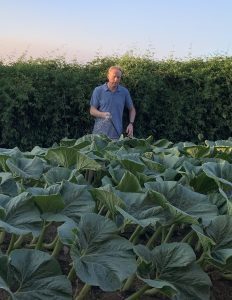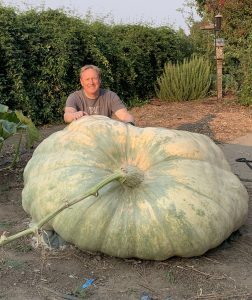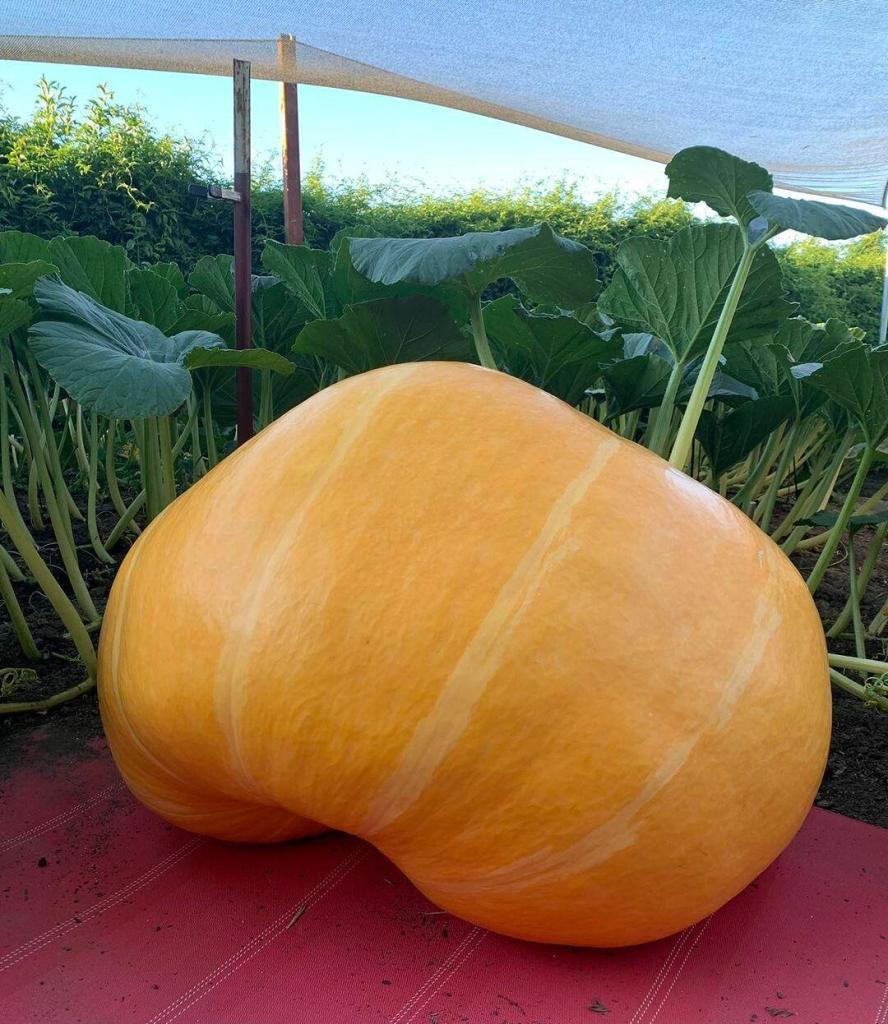Curious about cultivating a colossal 2,000-pound pumpkin? Whether you’re aiming to introduce an Atlantic Giant Pumpkin to your garden this year, delve into the secrets of giant gourd growth right here.
In this short guide, I’ll cover everything from choosing the right location to harvesting your pumpkins. Whether you are a seasoned gardener or just starting out, be sure to read through our tips carefully. With a bit of effort, the proper technique, and knowledge, you can successfully grow a giant gourd in your backyard.
For detailed information and more giant pumpkin growing secrets, see my book, Backyard Big: Growing Atlantic Giant Pumpkins in your Backyard.
Planting Site
To embark on the journey of cultivating these colossal pumpkins, your first and foremost task is to choose the optimal location. These giants thrive on ample sunlight, so identify a spot in your yard that basks in at least five to seven hours of direct sunlight daily. While it’s possible to nurture pumpkins exceeding 1,000 pounds in a 150-square-foot area (commonly seen in competitions), for optimal results, it’s recommended to allocate at least 300 square feet. Windbreaks, such as hedges or fences, provide an added advantage.
Once you’ve secured the perfect location, the next step involves preparing the soil. Robust gourds, including giants, flourish in well-drained soil rich in organic matter. If your soil falls short, consider enhancing it with compost or manure before planting. Seasoned growers often conduct soil tests to assess its health and suitability for cultivating giants. It’s a common practice to supplement the soil with nutrients and additives before the onset of the growing season.
Seeds
Next, you’ll need to purchase some Atlantic Giant Pumpkin seeds. You can find this specific variety of seed at online retailers or through garden clubs. Once you have gathered the seeds you need, it’s time to get them started indoors. Fill a small planting pot with some well-drained potting mix and plant one seed in it. Keep the soil moist (a little wet) but not completely soaked, and place the pot in a warm, sunny location.
After about a week, you should see the seed sprout. The genetic background and type of seed is one of the most important factors in successfully growing a giant. The “you get what you pay for” rule applies to Atlantic Giant seeds. Be cautious if you are purchasing inexpensive seeds that don’t have any genetic background described. Championship winning seeds can vary in cost, ranging between $25 and $200 for one seed. Purchases through clubs and or trades can reduce these costs. For details on finding that perfect seed, see my blog on Finding Good Seeds.
Planting
The optimal period to plant pumpkins is in late spring, after the last frost has passed. As warm-weather crops, pumpkins thrive when planted in soil that has had a chance to warm up. In regions with an extended growing season, kickstart your pumpkin plants indoors and later transplant them into the garden. This strategy provides a growth advantage, resulting in the cultivation of extra-large pumpkins!
When your seedlings and plants reach maturity, it’s time for the outdoor transplant. Wait until the risk of frost has completely subsided before introducing them to the ground. Select an open, sunlit area in your garden with well-drained soil. Ensure the planting holes are twice as wide as the root balls of your seedlings and equally deep.
For an even better approach, dig a hole three feet deep and four feet wide, layering it with straw, manure, decomposing leaves, compost, and garden soil. It’s advisable to prepare this hole several months prior to planting. Gently loosen the roots and position the plant in the ground. If the main vine is discernible, direct the pumpkins in your desired growth direction. Fill the holes with soil and water the area thoroughly.
Plant Care

As your gourds begin to grow, you’ll need to check the plant frequently. As they continue to increase in size, be sure to keep an eye on them and water them regularly. There are many resources listing the best fertilizer for giants, and the topic is detailed. Because there are unique growth stages of your plant, unique nutrients are used for each stage. For example, during the first stage of plant growth, phosphorus is important for root development, and after the first stage, nitrogen is needed to boost plant growth. It is recommended to use organic fertilizers and adjuncts in your patch for long-term soil health.
Pumpkins are susceptible to a variety of insects and diseases, but don’t let that deter you from growing them! There are, luckily, a few easy things you can do to protect your plants. To start, make sure you plant them in an area that has proper drainage. Wet conditions can lead to fungal diseases like powdery mildew, so it’s critical to give your plants a fighting chance by planting them in well-drained soil. Common pests include cucumber beetles, squash bugs, and aphids. If you see any of these critters or bugs on your plants, take action immediately! To get rid of pests, pick them up by hand or use an insecticide.
Finally, practice proper crop rotation. Crop rotation is the technique or process of growing different crops in the same area in successive years. This helps break the life cycle of pests and diseases and also adds nutrients back to the soil. When you’re planning or designing your garden, make sure to rotate your pumpkin plants so that they don’t grow in the same spot year after year.
Harvesting your Giant and Final Thoughts

Once you have a giant growing in your patch, you will need to decide if you want to enter it in a local weigh-off, move it to another location for display, or just leave it where it is. Pumpkins are mostly finished growing when they turn orange. There is a possibility that your Atlantic Giant Pumpkin will be too large to move, so many people leave them in their patch to display. Display your Atlantic Giant Pumpkin and enjoy all that fall has to offer!
Moving a giant is challenging and unique to your location. For example, if yours is too large to fit through gates or from the backyard to the front of the house, you have some extra challenges. In extreme situations, cranes can be used to life the pumpkins over houses! If your giant is not too large, it is possible to move it with several friends and a tarp. If it is greater than 500 pounds (ca. 227 kg), it is recommended to use tripod lifts, chain hoists, and even tractors.
Disposing of your pumpkin is easier than you might imagine. Before you dispose of it, make sure to remove the seeds and save them for future season. The seeds from your pumpkin are unique. One of a kind. Attach your name to your seeds. Pumpkins are devoured by certain live stock such as pigs and cows. They also decompose quickly in compost piles.
Last but not least, growing pumpkins is just plain fun! It’s an excellent time-passing activity to do with kids, and it’s really satisfying to see the fruits of your dedication and perseverance come to life. So what are you waiting for? Grab some seeds and get planting!
More Information
For more giant pumpkin growing secrets, see my book, Backyard Big: Growing Atlantic Giant Pumpkins in your Backyard, availabe on Amazon and Barnes & Noble. I also authored a gardening book called Backyard Big: Growing Food in Your Backyard.

